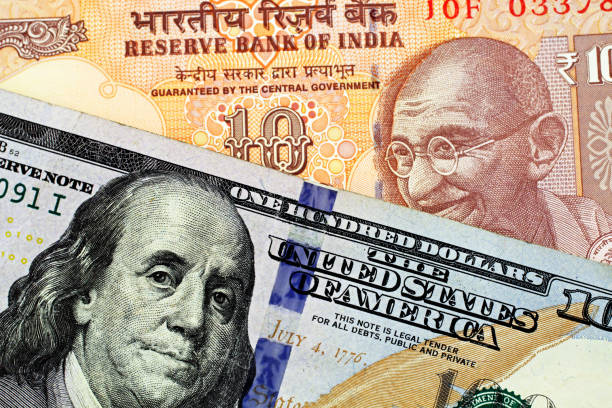The exchange rate between currencies is a fundamental aspect of global economics, influencing trade, investment, and international finance. Among the myriad of currency pairs, the USD to INR (United States Dollar to Indian Rupee) exchange rate holds particular significance due to the economic ties between the two countries. In this article, we’ll delve into the intricacies of this exchange rate, exploring its historical context, factors influencing its fluctuations, practical implications for individuals and businesses, and strategies for managing associated risks.
Introduction to the Exchange Rate
An exchange rate represents the value of one currency in terms of another. It plays a crucial role in facilitating international trade and investment by determining the cost of goods and services across borders. The USD to INR exchange rate indicates how many Indian Rupees one US Dollar can buy or vice versa.
Historical Context of the USD to INR Conversion Rate
The history of the USD to INR exchange rate is punctuated by various events and economic developments. From the era of fixed exchange rates to the current era of floating rates, the relationship between the two currencies has witnessed significant fluctuations influenced by factors such as geopolitical tensions, economic policies, and market sentiments.
Factors Influencing the Exchange Rate
Several factors contribute to the volatility of exchange rates, including economic indicators like GDP growth, inflation rates, interest rates, and trade balances. Political stability, geopolitical events, and market speculation also play a crucial role in shaping currency valuations.
Impact of Economic Indicators on the Exchange Rate
Economic indicators serve as barometers of a country’s economic health and exert considerable influence on its currency’s value. For instance, strong GDP growth or low inflation rates typically strengthen a currency, attracting foreign investors and driving up its exchange rate.
Comparison with Other Currencies
While the USD to INR exchange rate holds its significance, it’s essential to compare it with other major currencies to gauge its relative strength and stability. Understanding regional currency dynamics provides valuable insights into broader economic trends.
How Exchange Rates Affect Trade and Investment
Exchange rate fluctuations impact international trade by affecting the competitiveness of exports and imports. Similarly, investors must consider currency movements when making decisions about foreign investments, as exchange rate changes can significantly affect returns.
Practical Implications for Travelers and Investors
For individuals, understanding exchange rates is crucial when planning international trips or making investments in foreign assets. Fluctuations in currency values can impact the cost of travel and the value of investment portfolios, highlighting the need for prudent financial management.
The Role of Central Banks in Managing Exchange Rates
Central banks play a pivotal role in influencing exchange rates through monetary policy tools such as interest rate adjustments and currency interventions. Their actions aim to maintain economic stability and ensure orderly currency markets.
Current Trends and Forecasts
Analyzing current trends and expert forecasts provides valuable insights into the future direction of the USD to INR exchange rate. Factors such as economic growth prospects, geopolitical tensions, and central bank policies can shape short-term and long-term exchange rate movements.
Tips for Managing Currency Exchange Risks
Businesses and individuals can mitigate currency exchange risks through various hedging strategies and financial instruments. Diversification, forward contracts, and options trading are among the commonly employed techniques to manage exposure to exchange rate fluctuations.
Case Studies of Currency Fluctuations
Examining past currency crises and their impact on economies offers valuable lessons for understanding the dynamics of exchange rate movements. Case studies provide insights into the causes and consequences of currency volatility, informing risk management practices.
Strategies for Mitigating Currency Exchange Risks
Corporate entities often employ sophisticated risk management strategies to protect their finances from adverse currency movements. These may include natural hedging, balance sheet hedging, and strategic planning to minimize exposure to exchange rate risks.
Future Outlook for the USD to INR Exchange Rate
While predicting exchange rate movements with certainty is challenging, analyzing fundamental factors and emerging trends can provide valuable insights into future currency dynamics. Continued economic cooperation between the US and India, coupled with evolving global economic conditions, will likely influence the trajectory of the USD to INR exchange rate.
Conclusion
The USD to INR exchange rate is a vital metric in the realm of international finance, reflecting the economic ties between the United States and India. Understanding the factors driving its fluctuations and implementing effective risk management strategies is essential for individuals and businesses navigating the complexities of global currency markets.
FAQs (Frequently Asked Questions)
Q. How often do exchange rates change?
A. Exchange rates can fluctuate daily or even hourly, depending on market conditions and economic events.
Q. Can individuals predict currency movements accurately?
A. While some individuals and entities may successfully forecast currency movements, predicting exchange rates with absolute certainty is challenging due to the myriad of factors influencing them.
Q. What impact do exchange rates have on tourism?
A. Exchange rate fluctuations can affect the cost of international travel, making destinations more or less affordable for tourists depending on their home currency’s strength.
Q. How do central banks intervene in currency markets?
A. Central banks may buy or sell currencies in the foreign exchange market to influence their value, often as part of efforts to stabilize their domestic economies or address imbalances.
Q. Are there any risks associated with currency hedging?
A. While hedging can help mitigate exchange rate risks, it also entails costs and may not always provide complete protection against adverse currency movements.

